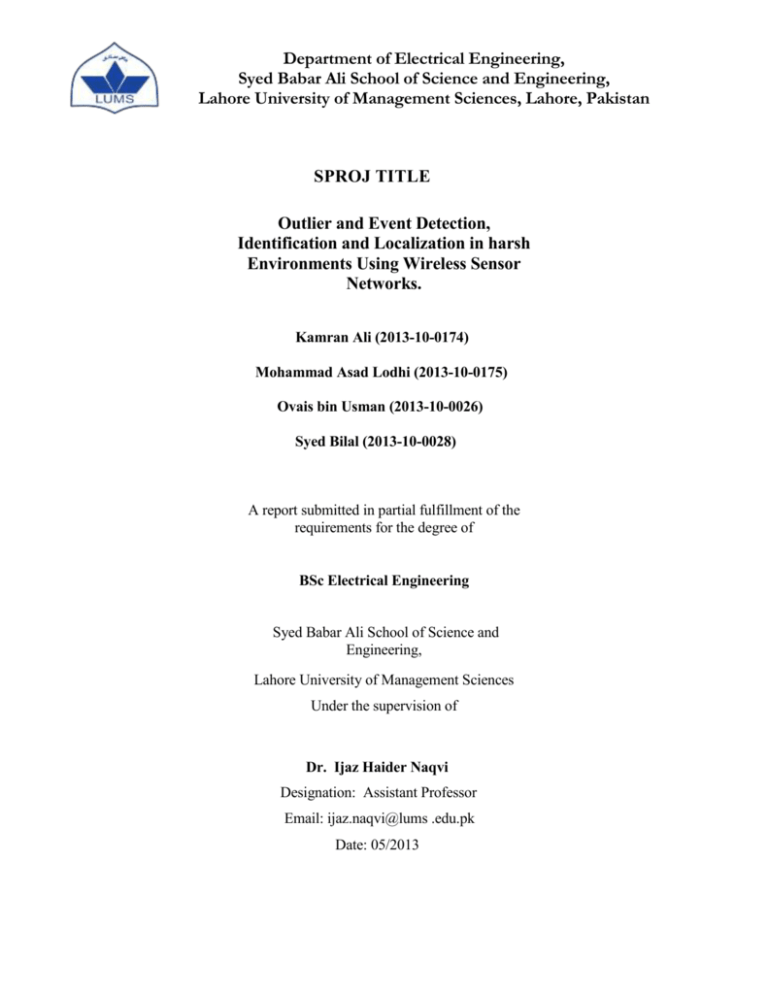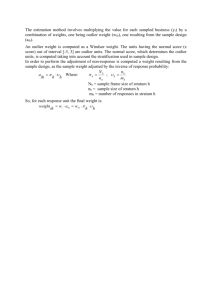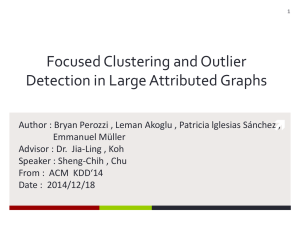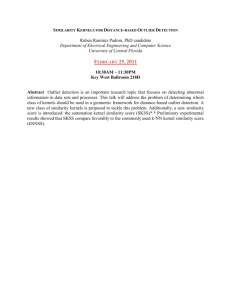Power Optimization of a Channel Coder adapted for WSN
advertisement

Department of Electrical Engineering,
Syed Babar Ali School of Science and Engineering,
Lahore University of Management Sciences, Lahore, Pakistan
SPROJ TITLE
Outlier and Event Detection,
Identification and Localization in harsh
Environments Using Wireless Sensor
Networks.
Kamran Ali (2013-10-0174)
Mohammad Asad Lodhi (2013-10-0175)
Ovais bin Usman (2013-10-0026)
Syed Bilal (2013-10-0028)
A report submitted in partial fulfillment of the
requirements for the degree of
BSc Electrical Engineering
Syed Babar Ali School of Science and
Engineering,
Lahore University of Management Sciences
Under the supervision of
Dr. Ijaz Haider Naqvi
Designation: Assistant Professor
Email: ijaz.naqvi@lums .edu.pk
Date: 05/2013
Table of Contents
Acknowledgments ...................................................................................................................................
Chapter 1: Problem Statement /Introduction .................................................................................
Chapter 2: Definitions and Notations ...............................................................................................
Chapter 3: Iterative Algorithm for Outlier Detection ...................................................................
3.1 The Algorithm
3.2 Optimization of Detection Rate (DR) and False Positive Rates (FPR)
Chapter 4: Event Detection
Chapter 5: Event Identification
5.1 The Algorithm
5.2 Results and Simulations
Chapter 6: Iterative Smoothing Techniques
6.1 The Algorithm
6.2 Results
Chapter 7: Localization
7.1 The Algorithm
7.2 Results
Chapter 8: Conclusion
References ..................................................................................................................................................
i
Sproj Title: Outlier and Event Detection, Identification and Localization in Harsh Environments
using WSNs.
Sproj Title: Outlier and Event Detection, Identification and Localization in Harsh Environments
using WSNs.
ACKNOWLEDGMENTS
First and foremost, we would like to thank to our supervisor of this project, Dr. Ijaz Haider
Naqvi for the valuable guidance and advice. He inspired us greatly to work in this project.
His willingness to motivate us contributed tremendously to our project. We also would
like to thank his for showing us some example that related to the topic of our project.
Besides, we would like to thank the authority Lahore University of Management SciencesEE department for providing us with a good environment and facilities to complete this
project. Also, we would like to take this opportunity to thank Sir Aqeel and Nauman
Shahid for their constant help to complete this project and see it through. Finally, an
honorable mention goes to our families and friends for their understandings and supports
to complete this project.
Sproj Title: Outlier and Event Detection, Identification and Localization in Harsh Environments
using WSNs.
Chapter 1:
INTRODUCTION AND PROBLEM STATMENT:
Outliers are sensed data measurements in a Wireless Sensor Network that significantly
deviate from the normal pattern. [1][2]. The application of outlier detection in filtration of
false data, finding faulty nodes and identification of events of interest has attracted
significant attention of the research community in recent years. Extensive surveys on
characterization and classification of outlier detection techniques [1][3][4] suggest that
clustering based algorithms are of significant importance as they are computationally
inexpensive, do not require prior knowledge of data distribution, can be used in an
incremental model and achieve high detection and low false positive rates. Despite its
numerous advantages, the use of clustering based algorithms for Event Detection and
Identification has not received extensive treatment in literature. An event can be
characterized as an unexpected change in environmental conditions or a hazardous
condition for example a fire or gas leakage etc [3]. Event detection and identification,
therefore finds application for safety purposes. Formally, a sequence of outliers that show
correlation in time and space correspond to an event. Significant research exists on
clustering based techniques for outlier detection. For example, the algorithm presented in
[5] lays a mathematical foundation for estimating a hyperellipsoidal boundary between
normal data and outliers. In [6], the algorithm presented in [5] has been modified to
incrementally update the elliptical boundary. The authors of [7] present a way of merging
clusters based on their similarity, for global outlier detection. Although these techniques
are very effective for outlier detection, they have not yet been used for event detection and
identification. Recently, the authors of [8] have proposed an algorithm for event detection
by projecting the hyperellipsoids on to single attribute subspaces and analyzing each
Sproj Title: Outlier and Event Detection, Identification and Localization in Harsh Environments
using WSNs.
subspace individually to identify an event, but the algorithm does not accommodate
correlation between multiple attributes and is susceptible. Single attribute faults. This
paper addresses some of these problems by first presenting an iterative model for
hyperellipsoidal clustering and then extending it to a novel Event detection and
Identification algorithm. The main contributions of this project can be summarized as
follows:
It presents the mathematical model behind hyperellipsoidal clustering algorithms
used for outlier detection.
It suggests a modification to the clustering algorithm to accurately update the
elliptical boundary iteratively.
It provides a method for optimizing the Detection Rate and False Positive Rate
using a Moving Average Filter
It provides a novel set of conditions that can be used to classify a sequence of
outliers as an event.
It proposes an algorithm for identifying the event by quantifying the relative
contributions of the attributes.
Sproj Title: Outlier and Event Detection, Identification and Localization in Harsh Environments
using WSNs.
Chapter:2
DEFINATIONS AND NOTATIONS
To describe the hyperellipsoidal model for outlier and event detection we first introduce
the required definitions. Let 𝑋k = {𝑥1, 𝑥2, ⋯ , 𝑥k} be the first 𝑘 samples of data collected
at a node in a WSN where each sample 𝑥i is a 𝑑 × 1 vector in ℝ𝑑 . Each element in the
vector represents an attribute 𝑎𝑗 for example temperature, pressure etc. The sample
arithmetic mean or the first moment 𝑚𝑋,𝑘 can be calculated using Eq.1. The second
moment 𝑚𝑋 2 ,𝑘 is calculated using Eq.2. The covariance 𝑆𝑘 in terms of 𝑚𝑋,𝑘 and 𝑚𝑋 2 ,𝑘 is
given by Eq.3
𝑘
𝑚𝑋,𝑘
1
= ∑ 𝑥𝑖
𝑘
(1)
𝑘
(2)
𝑖=1
𝑚𝑋 2 ,𝑘
1
= ∑ 𝑥𝑖 𝑥𝑖𝑇
𝑘
𝑖=1
𝑇
𝑆𝑘 = 𝑚𝑋 2 ,𝑘 − (𝑚𝑋,𝑘 𝑚𝑋,𝑘
)
(3)
The hyperellipsoidal boundary 𝑒𝑘 surrounding the data is defined as the set of k data
samples whose mahalanobis distance is less than 𝑡, the effective radius of the
hyperellipsoid [7]. 𝑡 can be found by the inverse chi squared distribution i.e. 𝑡 2 =
(𝜒𝑑 2 )−1 . [1]
Sproj Title: Outlier and Event Detection, Identification and Localization in Harsh Environments
using WSNs.
(4)
𝑇
𝑒𝑘 (𝑚𝑘 , 𝑆𝑘−1 , 𝑡) = {𝑥𝑖 ∈ ℝ𝑑 |√(𝑥𝑖 − 𝑚𝑋,𝑘 ) 𝑆 −1 (𝑥𝑖 − 𝑚𝑋,𝑘 ) ≤ 𝑡}
𝐷𝑖 = 𝑚𝑎ℎ𝑎𝑙𝑜𝑛𝑜𝑏𝑖𝑠 𝑑𝑖𝑠𝑡𝑎𝑛𝑐𝑒 𝑜𝑓 𝑥𝑖
By substituting Eq.3 into Eq.4 we can define the hyperellipsoidal boundary as:
𝑒𝑘 (𝑚𝑋 , 𝑚𝑋 2 , 𝑡)=
(5)
𝑇
−1
𝑇
{𝑥𝑘 ∈ ℝ𝑑 |√(𝑥𝑖 − 𝑚𝑋,𝑘 ) (𝑚𝑋 2 ,𝑘 − (𝑚𝑋,𝑘 𝑚𝑋,𝑘
))
(𝑥𝑖 − 𝑚𝑋,𝑘 ) ≤ 𝑡}
Eq.5 removes 𝑆𝑘 from the equation and represents 𝑒𝑘 entirely in terms of means. This step
makes it possible to write this equation in an iterative form (Section II).
Outliers are the data samples 𝑥𝑖 which are not enclosed in the hyperellipsoidal boundary,
Eq.6. Assuming data follows a multivariate normal distribution [2], then up to 98% of the
data can be enclosed by choosing an effective radius 𝑡 such that 𝑡 2 = (𝜒𝑑 2 )−1
0.98 [1].
Sproj Title: Outlier and Event Detection, Identification and Localization in Harsh Environments
using WSNs.
Chapter 3
3.1 ITERATIVE ALGORITHM FOR OUTLIER DETECTION
It is often not practical to store all the samples of a streaming data and therefore an
iterative algorithm is required to update 𝑒𝑘 . Let 𝑥𝑘+1 be the most recent sample recorded
at a node. Eq.7 and Eq.8 can be used to update 𝑚𝑋(𝑘+1) and 𝑚𝑋 2 (𝑘+1) from the previous
means and 𝑒𝑘+1 can be found by using Eq.5. If 𝑥𝑘+1 ∉ 𝑒𝑘+1 then it is declared an outlier.
𝑘𝑚𝑋,𝑘 + 𝑥𝑘+1
𝑘+1
(6)
𝑇
𝑘𝑚𝑋 2 ,𝑘 + 𝑥𝑘+1 𝑥𝑘+1
𝑘+1
(7)
𝑚𝑋,𝑘+1 =
𝑚𝑋 2 ,𝑘+1 =
An exponential forgetting factor can be introduced to incorporate the effects of recent
measurements Eq.8. [1]
𝑚𝑘+1 =⋋ 𝑚𝑘 + (1 −⋋)𝑥𝑘+1
(8)
It is beneficial to update means instead of covariance 𝑆𝑘 because incrementing means
requires lower complexity and achieves higher accuracy as compared to the iterative
formula for incrementing the covariance matrix. [1]
Sproj Title: Outlier and Event Detection, Identification and Localization in Harsh Environments
using WSNs.
This Fig shows the effect of changing t on the elliptical boundary
This Fig represents how the elliptical boundary is iteratively updated.
Sproj Title: Outlier and Event Detection, Identification and Localization in Harsh Environments
using WSNs.
3.2 OPTIMIZATION OF DETECTION RATE (DR) AND FALSE POSITIVE
RATE (FPR) USING A MOVING AVERAGE FILTER
Random noise in the incoming data is one of the main reasons for degradation of DR and
FPR in outlier detection algorithms. The effect of random noise can be mitigated by
recursive implementation of a M point moving average filter given by this equation:
𝑀−1
1
𝑦[𝑖] = ∑ 𝑥[𝑖 − 𝑗]
𝑀
𝑗=0
where M is the window size of the filter. The value of M should be such that the DR is
maximized and FPR is minimized. Hence this results in an optimization problem subject
to two constraints. This optimal value for M can be found by modeling the data and
simulating the variation in DRs and FPRs with respect to M. The value of that
simultaneously optimizes the DR and FPR should then be used to pre-filter the random
noise before the data is forwarded for further processing. As shown in the section
smoothing the data using a moving average filter remarkably improves the DRs and FPRs
for noisy data.
Sproj Title: Outlier and Event Detection, Identification and Localization in Harsh Environments
using WSNs.
Chapter 4
EVENT DETECTION
An event is defined as a sequence of outliers correlated in both time and space. To detect
an event we therefore need to store the outliers that were detected via the iterative
algorithm in section II. Let 𝑘 be the most recent iteration at node 𝑞, and let 𝑜𝑗 be an outlier
that occurred at any previous iteration. We define an event array 𝐸𝑘 to be an array of
outliers that fulfills the following conditions:
1. A recently detected outlier 𝑜𝑘+1 will be pushed into 𝐸𝑘 iff 𝐸𝑘 is empty or there is
a difference of less than 𝑇 iterations between 𝑜𝑘+1 and the last entry of 𝐸𝑘 .
2. If no outlier is detected for 𝑇 iterations, 𝐸𝑘 is emptied.
3. If the size of 𝐸𝑘 increases beyond a threshold 𝑡𝑂 then a local event is declared at
node 𝑞.
These conditions ensure that the outliers based on which an event is declared are not too
many iterations apart i.e. they are temporally correlated, and also that they are significant
in number i.e. >𝑡𝑂 . The following figure summarizes the algorithm for event detection at a
node.
Sproj Title: Outlier and Event Detection, Identification and Localization in Harsh Environments
using WSNs.
Visualization of hyperellipsoidal clustering
Sproj Title: Outlier and Event Detection, Identification and Localization in Harsh Environments
using WSNs.
Once a local event is declared, we check if similar events occurred at the surrounding
nodes. The similarity can be quantitatively found by clustering 𝐸𝑘 at each node and
calculating the Bhattacharya similarity coefficient ‘𝑆’ between clusters Eq.9 [3][9].
𝑆=
1
𝑣1+𝑣2 −1
(𝑚1−𝑚2)(
) (𝑚1−𝑚2)
2
𝑒 −8
√𝑑𝑒𝑡(𝑣1)𝑑𝑒𝑡(𝑣2)
×√
𝑣1 + 𝑣2
𝑑𝑒𝑡 ( 2 )
(9)
𝑚1, 𝑚2 are means and 𝑣1, 𝑣2 are the covariance matrices of two clusters 𝑒𝑘 1 and 𝑒𝑘 2,
and 𝑆 is their similarity on a scale of 0 to 1. If 𝑆 between node 𝑞 and its surrounding nodes
is high the event at 𝑞 spatially correlated and hence qualifies as a valid Event. Next 𝐸𝑘 is
forwarded for Event Identification.
Note: Please Move to next page for Chapter 5 Event Identification.
Sproj Title: Outlier and Event Detection, Identification and Localization in Harsh Environments
using WSNs.
Chapter 5
EVENT IDENTIFICATION
5.1 The Algorithm
In [4], an event identification technique is proposed where 𝑒𝑘 is projected on to a subspace
𝑋 𝑝 which contains only the 𝑝𝑡ℎ attribute, and the attribute contributing most towards the
event is identified based on deviation of individual projections. In this paper we modify
the algorithm by projecting 𝑒 𝑘 on to a subspace 𝑋 𝑝′ which contains all attributes except
the 𝑝𝑡ℎ attribute. Hence if 𝑋 is a 𝑑 dimensional column vector, 𝑋 𝑝′ is a (𝑑 − 1)
dimensional column vector. The advantage of using this algorithm over the single attribute
projection algorithm is that attributes are often correlated, and a subspace of multiple
attributes ensures that this correlation is incorporated towards the decision. It is also more
robust to errors that might occur in measurements of individual attributes. The algorithm is
presented in the following three steps:
STEP 1: Defining the Projection: We began by first projecting the arguments of the
Mahalanobis distance Eq.6 on 𝑋 𝑝′ .
Let 𝐸𝑘 be a 𝑑 × 𝑘 matrix with 𝑘 data samples and 𝑑 attributes per sample. We define
𝑃𝑟𝑜𝑗(𝐸𝑘 )𝑝′ to be the projection of 𝐸𝑘 along subspace 𝑋 𝑝′ . 𝑃𝑟𝑜𝑗(𝐸𝑘 )𝑝′ is obtained by
removing the 𝑝𝑡ℎ row of 𝐸𝑘 , resulting in a (𝑑 − 1) × 𝑘 matrix. 𝑃𝑟𝑜𝑗(𝐸𝑘 )𝑝′ ∀𝑝 =
1,2, ⋯ , 𝑑 gives the projections of 𝐸𝑘 along all 𝑑 subspaces, each excluding the 𝑝𝑡ℎ
attribute.
𝑃𝑟𝑜𝑗(𝐸𝑘 ) = {𝑃𝑟𝑜𝑗(𝐸𝑘 )1′ , 𝑃𝑟𝑜𝑗(𝐸𝑘 )2′ , ⋯ 𝑃𝑟𝑜𝑗(𝐸𝑘 )𝑑′ }
Similarly 𝑚𝐸𝑘 , which is a 𝑑 × 1 column vector representing the mean of 𝐸𝑘 , can be
projected on to 𝑋 𝑝′ by removing the 𝑝𝑡ℎ row entry. The resulting 𝑃𝑟𝑜𝑗(𝑚𝐸𝑘 )𝑝′ ∀𝑝 =
1,2, ⋯ , 𝑑 gives a set of means of each projection in the set 𝑃𝑟𝑜𝑗(𝑚𝐸𝑘 ).
𝑃𝑟𝑜𝑗(𝑚𝐸𝑘 ) = {𝑃𝑟𝑜𝑗(𝑚𝐸𝑘 )1′ , 𝑃𝑟𝑜𝑗(𝑚𝐸𝑘 )2′ , ⋯ 𝑃𝑟𝑜𝑗(𝑚𝐸𝑘 )𝑑′ }
Sproj Title: Outlier and Event Detection, Identification and Localization in Harsh Environments
using WSNs.
𝑆𝑋𝑘 is a 𝑑 × 𝑑 covariance matrix obtained from Eq.3 where the 𝑝𝑡ℎ attribute has
contribution on both the 𝑝𝑡ℎ row and the 𝑝𝑡ℎ column. 𝑃𝑟𝑜𝑗( 𝑆𝑋𝑘 )𝑝′ is obtained by
removing the 𝑝𝑡ℎ row and 𝑝𝑡ℎ column of the matrix 𝑆𝑋𝑘 , resulting in a (𝑑 − 1) × (𝑑 −
1) matrix.
STEP 2: Mahalanobis Distance of the Projections: Once projections of all the
arguments of the Mahalanobis distance have been found, the Mahalanobis distances 𝐷𝑝′
can be found simply inserting these arguments into the Eq.10:
′
′
′
′
𝑇
′
′
𝑝
𝑝
𝑝
𝑝 −1
𝑝
𝐷𝑘𝑝 (𝑚𝐸𝑘
, 𝑆𝐸𝑘
, 𝑡) = √(𝑜𝑖𝑝′ − 𝑚𝐸𝑘
) 𝑆𝐸𝑘
(𝑜𝑖𝑝′ − 𝑚𝐸𝑘
)
(10)
∀𝑖 = 1,2, ⋯ , 𝑘
′
′
𝑝
𝑝
𝑜𝑖𝑝′ , 𝑚𝐸𝑘
, 𝑆𝐸𝑘
are the projections of Data sample 𝑜𝑖 , mean 𝑀𝑋𝑘 and covariance matrix 𝑆𝑋𝑘
respectively, on the 𝑝𝑡ℎ subspace. For a particular value of 𝑝 , 𝐷𝑖𝑝′ is an array of the
mahalanobis
distances
of each column in
𝑃𝑟𝑜𝑗(𝐸𝑘 )𝑝′
for example 𝐷𝑘𝑝′ =
′
{𝐷11 , 𝐷21′ , ⋯ , 𝐷𝑘1′ }.
STEP 3:
Decision Formulation: The results are based on the deviation of the
Mahalanobis distances of the projections from the original Mahalanobis distance. Let 𝐷𝑘
be the array of mahalanobis distances of the original 𝑑 dimentional sample 𝑋𝑘 . We define
𝑅𝑘𝑝 to be the decision array for the 𝑝𝑡ℎ attribute; it is given by the equation:
𝑅𝑘𝑝 = 𝐷𝑘 − 𝐷𝑘𝑝′
(11)
If 𝐸𝑘 consists of 𝑘 samples, then the elements of 𝑅𝑘𝑝 signify the contribution of attribute 𝑝
towards each of the 𝑘 samples. ̅̅̅̅
𝑅𝑘𝑝 , which is mean of the array 𝑅𝑘𝑝 gives a measure of the
average contribution of 𝑝 towards the event. The attribute that contributes most towards
the event is given by:
̅̅̅̅𝑝 ) 𝑓𝑜𝑟 𝑝 = 1,2, ⋯ 𝑑
max(𝑅
𝑘
(12)
Sproj Title: Outlier and Event Detection, Identification and Localization in Harsh Environments
using WSNs.
Event Identified using the mentioned algorithm is shown in this figure.
5.2 RESULTS AND SIMULATIONS
Simulations were performed in Matlab two a normally distributed 4-dimensional synthetic
data sets consisting of 4000 samples each.
Sproj Title: Outlier and Event Detection, Identification and Localization in Harsh Environments
using WSNs.
Each dimension corresponding to a single attribute is plotted with respect to time in
Figure 4 and Figure 5. In the first data set, an event is introduced in the 1st attribute
centered at the 2500th sample. The second and third attribute are correlated to the first
attribute and hence show slight variations when the event occurs. The 4th attribute is
uncorrelated to the other three. In the second data set all attributes are independent and an
event occurs in the 1st attribute. A. Finding the optimal value of M M can be optimized by
simulating curves for DR and FPR vs. M. the curves for the given dataset are shown in the
Figure. It can be seen that both DR and FPR approximately hit their maximum and
minimum values at M=50.
Outlier Detection:
Three outlier detection techniques were performed on the Dataset:
1) Cumulative clustering: To determine if the nth sample is an outlier, all samples
until the nth sample are clustered and the Mahalanobis distance for the nth
sample is calculated using Eq. (4). This technique is not practical as it would
require storage of all n samples which is not possible in case of low memory
nodes. However this is the most accurate technique as the knowledge of all the
previous data is available while making the decision.
Sproj Title: Outlier and Event Detection, Identification and Localization in Harsh Environments
using WSNs.
2) Iterative clustering purposed in [6]: The covariance matrix is estimated from the
covariance matrix of the previous iteration and substituted into Eq. (4) to make
the decision. A loss of precision occurs during the estimation of the covariance
matrix and results in a relatively low detection rate (DR) and high false positive
rate (FPR) than the other two purposed techniques.
3) Iterative clustering via moments purposed in section II: Here the equation for
Mahalanobis distance is simplified in terms of the first and second moment
which are incremented with complete precision hence the results for DR and FPR
come out to be similar the cumulative clustering technique. As shown in section
II, outlier detection only requires the moments of the previous iteration and hence
this method is compatible with low memory nodes.
The results for FPR and DR for the three mentioned techniques are summarized in these
tables:
Sproj Title: Outlier and Event Detection, Identification and Localization in Harsh Environments
using WSNs.
Event Detection and Identification:
The Event Detection algorithm mentioned in section IV was applied to the data. Keeping
T = 20 and to = 5, an event was recorded with duration from the 2010th sample to the
2700th sample as indicated by the shaded region. This Figure above shows the decision
array Rp for p = 1, 2, 3, 4 of the data sets respectively.
The contributions of each attribute over the duration of the event are shown. The event is
initiated in attribute 1 which solely contributes towards the event till the 2250th sample
after which the effect of attribute 1 dies down and attribute 2 and 3 contribute significantly
towards the event. Attribute 4 does not make a significant contribution towards the event
Sproj Title: Outlier and Event Detection, Identification and Localization in Harsh Environments
using WSNs.
throughout the duration of the event. Rkp which is the normalized mean contribution
towards the event by each attribute is represented by this Figure.
Sproj Title: Outlier and Event Detection, Identification and Localization in Harsh Environments
using WSNs.
Chapter 6
ITERATIVE SMOOTHING TECHNIQUES:
6.1 The Algorithm
One of the main reasons for having False Positives in Outlier Detection results is the fast
variation in the incoming data. Moreover, some data contain a certain degree of periodicity
() and trends. Therefore, there was a need to come up with an algorithm that smoothed the
data, thus improving the FPRs and DRs as well.
One approach was using the Moving Average (M.A.) Filter was that the optimum size of
the window for good FPRs and DRs was data dependent. In case of noisy data like in
Figure 1, the results didn’t change much with varying size of the filter. But in data like
shown in Figure 2, which include periodicity and trendy variations (an example would be
wind blowing in a storm with varying speeds), the FPRs and DRs changed considerably
with size of M.A. Filter. Moreover the outlierness of the outliers decreases if larger size
windows are used. E.g. if a window size of 25 is used and after 20 normal readings, if 4 or
5 outliers come, the smoothed will value less. The reasons why M.A. filter was not
pursued are thus summed up below:
1. The window size is a significant factor which is user defined parameter and gives
different results for different readings.
2. The outlier-ness of the outliers is decreased which is bound to affect Detection
Rates.
3. Variations like shown in Figure 1 are usually very low compared to the useful
data and filters are already implemented in the hardware at DSP level to
average/filter such data.
Sproj Title: Outlier and Event Detection, Identification and Localization in Harsh Environments
using WSNs.
4. Noise as shown in Figure 1 is usually concentrated near mean/center of ellipsoids
and due to this reason and the one mentioned in point 3 above such reading are
seldom detected as False Positives.
The aim was to bind the data variations as tightly as possible by the hyper-ellipsoid
without affecting “outlier-ness” of the outliers. This will lead to minimization of False
Positive Rates and increase in DRs.
The algorithm developed resulted in excellent results boasting not only low False Positive
Rates (FPR) but, at the same time, approaching 100 % Detection Rates (DR). Smoothing
and the underlying outlier/event detection algorithm are both still iterative. The technique
is named Iterative Smoothing with Independent Forgetting Factors (ISIF).
Following is are the equations representing the technique. X’k+1 is the smoothing version
of the incoming data, MX,k is the mean updated before X’k+1 and MX,k+1 is the updated
mean after the reading. What this method of updating the mean does to the data is shown
in Figure 3. Variations become close without affecting much the outlier-ness of a reading.
More variations bounded by incremental ellipsoids. This leads to very low FPRs and high
DRs.
Here λm and λn take values between 0.9 to 0.999.
Sproj Title: Outlier and Event Detection, Identification and Localization in Harsh Environments
using WSNs.
Sproj Title: Outlier and Event Detection, Identification and Localization in Harsh Environments
using WSNs.
Sproj Title: Outlier and Event Detection, Identification and Localization in Harsh Environments
using WSNs.
6.2 Results:
In the start of this section there is an introduction to the data sets used in the evaluation of
different methods. Methods with which the results of this algorithm were compared with
are as follows,
1. Batch Approach - in this approach the Covariance Matrix and the Mean is
calculated once for the whole batch or data set.
2. Forgetting Factor (FF) Iterative DCAD (FFIDCAD) Approach - this technique is
discussed in the paper by Masudet. al. In this technique both Mean and
Covariance Matrix are iteratively updated using a forgetting factor λ. This
technique enables the basic IDCAD to track data variation in the monitored
environment.
3. N-effective Iterative DCAD Approach - this is another technique presented by
Masudet. al. This technique introduces a sliding window based, low complexity
approach which is proposed to deal with the effect of a large number of readings
on the calculation of
Covariance and Mean.
Figure 4 shows the 2D results of outlier detection on Data Set 1 (attributes 1 and 2 only)
using all the four techniques, i.e., the ISIF (1), the batch technique in which the clustering
is applied on the whole batch at once (2), the IDCAD without Forgetting Factor (FF) (4)
and the
FFIDCAD (3) with FF taken to be 0.999.
Sproj Title: Outlier and Event Detection, Identification and Localization in Harsh Environments
using WSNs.
Sproj Title: Outlier and Event Detection, Identification and Localization in Harsh Environments
using WSNs.
Sproj Title: Outlier and Event Detection, Identification and Localization in Harsh Environments
using WSNs.
Chapter 7
LOCALIZATION:
7.1 The Algorithms
After successful detection and identification of the event our next task was to localize it.
For Event Localization we developed a simple technique which uses an iterative approach
to localize an event within 10-15 iterations.
Setup:
Motes are setup such that there is high power mote at the center of an area of some radius
R. This high power mote is capable of doing complex computations and the event
Sproj Title: Outlier and Event Detection, Identification and Localization in Harsh Environments
using WSNs.
localization algorithm will run on this mote. The low power motes in the area sense the
event and communicate the event intensities calculated using our event detection
algorithm, to the center high power mote. Right now we are not considering the event
intensity measured at the center HP mote itself.
Assumptions:
Following are some assumptions behind the algorithm,
a) Intensity of an Event calculated at each node roughly follows a model for event
intensity Example
Usual fall-off of event intensity w.r.t distance is
𝐸𝑣𝑒𝑛𝑡 𝐼𝑛𝑡𝑒𝑛𝑠𝑖𝑡𝑦(𝐼𝑒 ) =
𝑘
𝑑∝
Where d = distance of mote from the event, ∝ = fall-off factor (e.g. ∝ = 2 for light intensity) and 𝑘
= intensity constant.
b) Event intensity at a certain mote is stable for at-least the sampling interval of the ADC
on that mote.
c) Locations of the individual nodes are known at the center mote (e.g. GPS, or any other
localization algorithm).
d) The motes are not moving. No mote leaves the environment.
e) Event can be dynamic
Terms:
Here are some of the terms which will be used in the formulation of the algorithm.
•
Position co-ordinates
𝑃𝑥𝑖 , 𝑃𝑦𝑖 𝑎𝑟𝑒 𝑡ℎ𝑒 2𝐷 𝑐𝑜𝑜𝑟𝑑𝑖𝑛𝑎𝑡𝑒𝑠 𝑜𝑓 𝑖 𝑡ℎ 𝑚𝑜𝑡𝑒
•
Actual Event Location (𝑒𝑥 , 𝑒𝑦 )
Sproj Title: Outlier and Event Detection, Identification and Localization in Harsh Environments
using WSNs.
•
Estimated Event Location (𝐸𝑥 , 𝐸𝑦 )
•
No. of nodes = n
•
𝐼𝑒𝑖 is the event intensity communicated to center by each node
Process:
•
All motes communicate the calculated Event Intensities to the center high power
mote
•
Center has following information :
1. Positions 𝑃𝑥1 , 𝑃𝑦1 … 𝑃𝑥𝑛 , 𝑃𝑦𝑛
2. Inte𝑛𝑠𝑖𝑡𝑖𝑒𝑠 𝐼𝑥1 , 𝐼𝑦1 … 𝐼𝑥𝑛 , 𝐼𝑦𝑛
a) The first step in the process is to subtract the mean of the positions from the
positions of the motes known at center to get𝑃𝑥′1 , 𝑃′1𝑦 … 𝑃𝑥′𝑛 , 𝑃𝑦′𝑛 . This gives
new set of positions denoted by an apostrophe sign here. It will become clear in
the second step why this was done. The reference becomes the mean of these
motes.
b) The second step is that each mote position is given a weight equal to event
intensity for that mote and we divide by the sum of calculated intensities. You
can now see why we subtracted the mean. This is because if the position coordinates of a mote (where intensity of event was low) are of considerably large
value w.r.t to the other motes (where intensity of event was relatively high) then
that mote can contribute more to this sum in the numerator. Subtracting the mean
makes sure that each position’s contribution to the numerator is fair locations of
each mote.
Sproj Title: Outlier and Event Detection, Identification and Localization in Harsh Environments
using WSNs.
𝑃′𝑖
∑𝑛𝑖=1 [ 𝑥′𝑖 ] 𝐼𝑒𝑖
𝑃𝑦
𝐸𝑥
[𝐸 ] =
𝑛
𝑦
∑𝑖=1 𝐼𝑒𝑖
c) Iterative Algorithm
For each node 𝑖 information,
1. Using the estimated location of the event, New Intensity is calculated
according to the assumed model. This intensity is the value of event
intensity ith mote would have calculated (approximately) if the event had
happened at the estimated location. We have used alpha = 2 and k = 2 in
𝑖
our simulation. So, we calculate 𝐼𝑛𝑒𝑤
by calculating new distance 𝑑𝑛𝑒𝑤 from
the estimated event point
𝑘
𝑖
𝐼𝑛𝑒𝑤
= 𝑑∝
𝑛𝑒𝑤
* using 𝑘 = 2, ∝ = 2 for the simulations.
2. Constraint Formulation:
In the 2nd step the constraints are formulated. Using the estimated position and the
new distance, we have our first constraint.
(𝑃′𝑖𝑥
2
− 𝐸𝑥 ) +
(𝑃′𝑖𝑦
2
− 𝐸𝑦 ) = [𝐼𝑖
2
∝
1
𝑛𝑒𝑤
] --------(1)
The other constraint is the one which depends on the actual event location (which is
still unknown) and the actual intensity of the event measured and communicated by
ith motes.
2
(𝑃′𝑖𝑥
2
− 𝑒𝑥 ) +
(𝑃′𝑖𝑦
2
− 𝑒𝑦 ) =
1 ∝
[𝐼 𝑖 ]
𝑒
-------- (2)
3. Using above constraints we come up with the following constraint which is
linear. The square term cancel out. On the RHS you have the known
information and on the left you have unknown quantities.
Sproj Title: Outlier and Event Detection, Identification and Localization in Harsh Environments
using WSNs.
𝑃′𝑖𝑥 𝑒𝑥
+
𝑃′𝑖𝑦 𝑒𝑦
𝑖
=𝐴 +
𝑃′𝑖𝑥 𝐸𝑥
+
𝑃′𝑖𝑦 𝐸𝑦
𝑖
𝑖
= 𝐵 where 𝐴 = 0.5 [[𝐼𝑖
1
𝑛𝑒𝑤
2
∝
] −
2
1 ∝
[𝐼 𝑖 ] ]
𝑒
4. For n nodes we get n constraints. This over constrained system can be
solved using LSQ method which can be obtained using the well-known
pseudo inverse technique. Here P is the position matrix and B is as above.
This gives us the new estimate of the event location. We can iterate through
these steps until we reach a certain precision, the value of which is set at the
start of the algorithm.
7.2 Results:
Here are some of the results for different number of motes and precision
values. The observations are,
1- If an event occurs in between a cluster of motes, it needs less iteration
to reach the event location.
2- For more precision you need more iterations.
3- The more the number of motes the less iteration it should take to reach
the event location.
4- Only 3 nodes are enough to localize an event.
Sproj Title: Outlier and Event Detection, Identification and Localization in Harsh Environments
using WSNs.
Sproj Title: Outlier and Event Detection, Identification and Localization in Harsh Environments
using WSNs.
Sproj Title: Outlier and Event Detection, Identification and Localization in Harsh Environments using
WSNs.
5
Sproj Title: Outlier and Event Detection, Identification and Localization in Harsh Environments using
WSNs.
Extension to detect dynamic events:
The algorithm can easily be extended for dynamic events. In that case each mote will be
communicating the dynamic event intensities to the center high power mote. The way the
algorithm is constructed, we don’t need to make any changes for dynamic event detection. The
algorithm iterative goes through solving the newly formed constraints. Thus it has the
capability to automatically track the dynamic event.
6
Sproj Title: Outlier and Event Detection, Identification and Localization in Harsh Environments using
WSNs.
7
Sproj Title: Outlier and Event Detection, Identification and Localization in Harsh Environments using
WSNs.
Chapter 8:
CONCLUSION
In this project the problem of Event detection and Identification via hyper-ellipsoidal clustering has
been addressed. First we introduce an iterative method for detection of anomalous data by
incrementally updating the first and second moments and using them to find the mahalanobis
distance of each sample. The samples whose mahalanobis distance exceeds the effective radius are
declared as outliers. The significance of smoothing out the data to remove random noise is also
demonstrated. Next we present a novel set of conditions for Event Detection. These conditions
check a sequence of outliers for Temporal and Spatial correlation. A sequence of outliers satisfying
these conditions is declared as an Event. The contribution of each sensed attribute is then
determined by an Event identification algorithm which projects the combined mahalanobis
distance on a subspace which neglects the attribute of interest and compares the resulting
mahalanobis distance with the combined mahalanobis distance to determine the contribution of
that attribute. We also show the effectiveness of the proposed techniques by simulating them on a
four dimensional data set and comparing the results with techniques mentioned in the literature.
The problems addressed in this project provide the research community with an opportunity for
further improve upon the proposed methods and determine
their effectiveness on a variety of simulated and experimental data.
8
Sproj Title: Outlier and Event Detection, Identification and Localization in Harsh Environments using
WSNs.
REFERENCES
[1] Y. Zhang, N. Meratnia, and P. Havinga, “Outlier detection techniques for wireless sensor
.
networks: A survey,” Communications Surveys & Tutorials, IEEE, vol. 12, no. 2, pp. 159–170,
2010.
[2] G. H. John, “Robust decision trees: Removing outliers from databases,” in Proceedings of the
First International Conference on Knowledge Discovery and Data Mining, pp. 174–179, AAAI
Press, Menlo Park, CA, 1995.
[3] N. Shahid, I. Naqvi, and S. Qaisar, “Characteristics and classification of outlier detection
techniques for wireless sensor networks in harsh environments: a survey,” Artificial Intelligence
Review, pp. 1–36, 2012.
[4] V. Chandola, A. Banerjee, and V. Kumar, “Anomaly detection: A survey,” ACM Computing
Surveys (CSUR), vol. 41, no. 3, p. 15, 2009.
[5] S. Rajasegarar, J. Bezdek, C. Leckie, and M. Palaniswami, “Elliptical anomalies in wireless
sensor networks,” ACM Transactions on Sensor Networks (TOSN), vol. 6, no. 1, p. 7, 2009.
[6] M. Moshtaghi, C. Leckie, S. Karunasekera, J. Bezdek, S. Rajasegarar, and M. Palaniswami,
“Incremental elliptical boundary estimation for anomaly detection in wireless sensor networks,”in
Data Mining (ICDM), 2011 IEEE 11th International Conference on, pp. 467–476, IEEE, 2011.
[7] M. Moshtaghi, S. Rajasegarar, C. Leckie, and S. Karunasekera, “Anomaly detection by
clustering ellipsoids in wireless sensor networks,” in Intelligent Sensors, Sensor Networks and
Information Processing (ISSNIP), 2009 5th International Conference on, pp. 331–336, IEEE, 2009.
9
Sproj Title: Outlier and Event Detection, Identification and Localization in Harsh Environments using
WSNs.
[8] N. Shahid, S. Ali, K. Ali, M. Lodhi, O. Usman, and I. Naqvi, “Joint eventdetection &
identification: A clustering based approach for wireless sensornetworks,” in 2013 IEEE Wireless
Communications and Networking Conference (WCNC), (Shanghai, P.R. China), pp. 1703–1708,
apr 2013.
[9] J. Bezdek, T. Havens, J. Keller, C. Leckie, L. Park, M. Palaniswami, and S. Rajasegarar,
“Clustering elliptical anomalies in sensor networks,” in Fuzzy Systems (FUZZ), 2010
IEEEInternational Conference on, pp. 1–8, IEEE, 2010.
[10] T. Kailath, “The divergence and bhattacharyya distance measures in signal selection,”
Communication Technology, IEEE Transactions on, vol. 15, no. 1, pp. 52–60, 1967.
10








